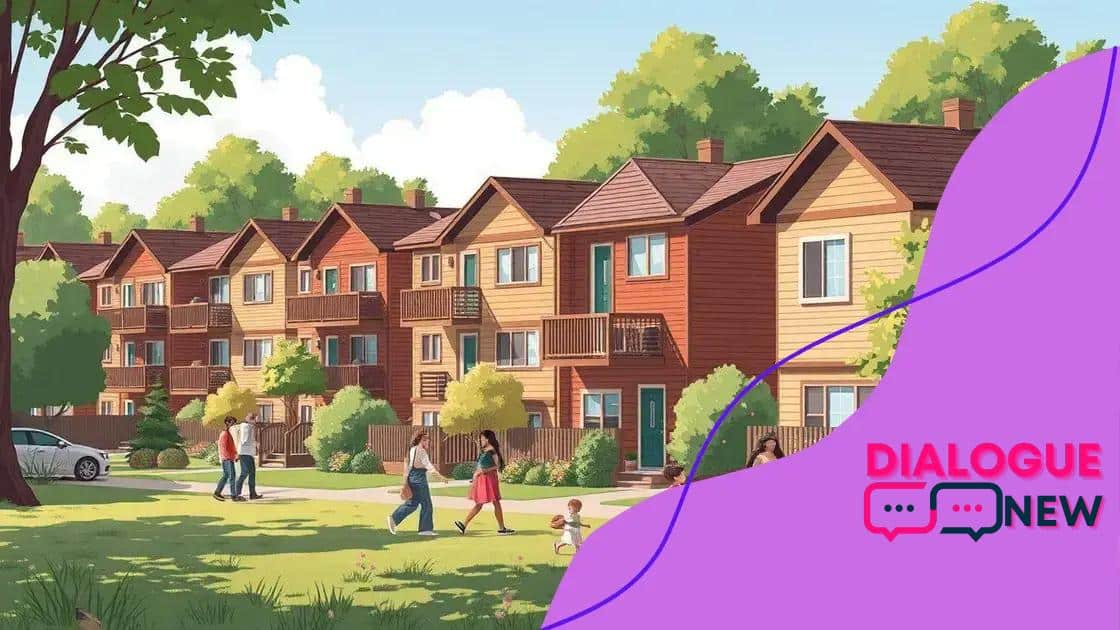Expanding access to affordable housing under new federal policies

Expanding access to affordable housing under new federal policies improves community stability, enhances health outcomes, and stimulates local economies through sustainable and collaborative development initiatives.
Expanding access to affordable housing under new federal policies is a crucial topic as many individuals struggle with housing insecurity. Have you ever wondered how these policies can change lives and reshape communities? Let’s dive into the details and explore their impact.
Understanding the new federal housing policies
Understanding the new federal housing policies is key to grasping how they can reshape our communities. These policies aim to make housing more accessible and affordable for everyone.
The first significant change introduced is a focus on reducing barriers to homeownership. Many families face challenges that make it hard to own a home, such as high mortgage rates and stringent qualification criteria. The government recognizes these issues and is working to provide solutions.
Key Features of New Policies
These policies include various aspects that directly affect homebuyers and renters. Let’s look at a few critical features:
- Increased funding for affordable housing projects.
- Incentives for developers to create low-income housing.
- Support for first-time homebuyers through grants and loans.
Benefits for Communities
As these policies take effect, the benefits extend beyond individual homeownership. Communities can expect to see revitalization and growth. More affordable housing means a more diverse population, leading to the cultural richness of neighborhoods.
Additionally, these policies aim to reduce homelessness and provide safe, stable living conditions for all. When people have a place to call home, they can contribute more effectively to society and the economy.
Understanding the new federal housing policies is essential for everyone, whether you’re considering buying a home or simply want to see your community thrive. Staying informed about these changes will help individuals and families navigate the housing market more effectively.
Key benefits of expanded access to affordable housing
The key benefits of expanded access to affordable housing are significant for individuals and communities alike. When more people can afford stable housing, it creates a ripple effect throughout society, touching various aspects of life.
One major advantage is the improvement in overall health. People living in secure and affordable housing tend to experience better health outcomes. They have a safer environment, which leads to lower stress levels. Furthermore, children growing up in stable homes have a higher chance of excelling in school.
Economic Advantages
Expanded access to affordable housing also brings economic benefits. When people can find homes they can afford, they have more disposable income to spend in local businesses. This creates job opportunities and boosts the economy.
- Increased consumer spending in local shops.
- Job creation in construction and maintenance.
- Attraction of new businesses to the area.
Social Stability
Additionally, as communities become more stable with affordable housing, social connections strengthen. Neighbors get to know one another, which fosters a sense of community. These social ties can lead to a more engaged and proactive citizenry.
Moreover, access to affordable housing helps alleviate homelessness. When housing is affordable, fewer people live on the streets or in shelters. This shift not only benefits the individuals but also reduces pressure on social services.
Understanding the key benefits of expanded access to affordable housing is essential for everyone. When communities prioritize these initiatives, they create a brighter future for all residents and contribute to a healthier, more vibrant society.
Challenges faced in implementing new policies

Implementing new policies for affordable housing is not without its challenges. Even with the best intentions, there are obstacles that must be navigated carefully.
One major challenge is funding. Many of these policies require significant financial resources to be effective. Finding sustainable funding sources to maintain and support affordable housing initiatives can be difficult. Community programs often depend on local government budgets, which may be limited or fluctuate year to year.
Regulatory Hurdles
Another challenge is the complex regulatory environment. Navigating zoning laws and building codes can be overwhelming for developers. This complexity can slow down the process of getting new housing projects off the ground.
- Local zoning restrictions may limit the type of housing that can be built.
- Building codes can increase construction costs.
- Strict regulations can deter developers from pursuing affordable projects.
Community Resistance
Moreover, there can be community resistance to new developments. Neighborhoods often have deep-rooted concerns about changes in their environment. Residents may fear that new housing will affect property values or lead to increased traffic.
Addressing these concerns requires effective communication and education. It is vital to involve the community early in the planning process to foster understanding and support. When residents are engaged in discussions, they can help shape solutions that meet everyone’s needs.
Finally, the need for collaboration between various stakeholders can also be a hurdle. Ensuring that government officials, developers, and community members are on the same page takes time and effort. Lack of coordination can delay progress, and each group may have different priorities.
Understanding the challenges faced in implementing new policies can help stakeholders prepare better and work collaboratively towards effective solutions. Acknowledging these obstacles is the first step in creating successful housing strategies for the future.
Success stories from communities adapting to changes
Success stories from communities adapting to changes in affordable housing policies showcase how effective these initiatives can be. Communities across the nation are finding innovative ways to implement new policies and improve the quality of life for their residents.
One shining example is a neighborhood that partnered with local government to transform vacant lots into affordable housing units. This project not only provided much-needed homes but also revitalized the area, leading to increased community engagement and pride. Residents, once skeptical, became strong supporters after seeing the positive impact on their neighborhood.
Collaborative Efforts
In another instance, a city collaborated with non-profit organizations to create affordable housing programs targeting low-income families. By pooling resources and expertise, they managed to supply housing that is both affordable and environmentally sustainable. This collaboration has effectively addressed homelessness while fostering healthy communities.
- Increased access to housing has improved educational outcomes for children.
- Residents now enjoy parks and recreational spaces as a result of revitalization.
- Community training programs have been introduced to support job placement.
Community Resilience
Many communities have shown remarkable resilience by adapting to new policies. For example, some areas have tackled discrimination in housing through awareness campaigns. These initiatives help educate landlords and tenants about their rights, leading to fairer practices.
Others have established community land trusts that allow residents to collectively own and manage properties. This model ensures that housing remains affordable over the long term and prevents displacement due to rising market prices.
These success stories illustrate how communities can thrive when they embrace change and work together. By learning from one another, they foster an environment of support and positivity. As more communities adapt to changes in affordable housing, we can expect to see continued improvements in quality of life.
Future trends in affordable housing initiatives
Future trends in affordable housing initiatives show great promise as communities adapt to changing needs. Innovative approaches are emerging that aim to make housing more accessible and sustainable for everyone.
One significant trend is the increased focus on sustainability. Developers are now integrating eco-friendly materials and energy-efficient designs in affordable housing projects. This shift not only reduces costs for residents but also helps protect the environment.
Technological Advancements
Technology is playing a major role in transforming affordable housing. Smart home technologies are becoming more common, allowing residents to save on utilities and improve their quality of life. For instance, smart thermostats can help manage energy consumption more effectively.
- Use of modular construction techniques to speed up building time.
- Online platforms for community engagement and feedback.
- Apps that help connect renters with affordable options.
Community-Centric Models
Another trend is the rise of community-centered models for housing. More neighborhoods are forming cooperatives where residents can collectively own and manage their homes. This ensures long-term affordability and stability for families.
Moreover, partnerships between local governments and non-profit organizations are increasingly common. Such collaborations can bring more resources and expertise together, ensuring that housing initiatives are both effective and responsive to community needs.
As public awareness grows, advocacy for affordable housing is likely to increase as well. Citizens are becoming more involved in discussions about housing policies, pushing for changes that reflect their needs and priorities. This grassroots involvement is crucial to shaping future initiatives.
By staying attentive to these trends, we can help ensure that future housing policies foster inclusivity and support sustainable living for all communities.
In conclusion, the journey toward expanding access to affordable housing is filled with both challenges and opportunities. As we have explored, community engagement, innovative policies, and collaboration among stakeholders are essential elements for success. With a focus on sustainability and the use of technology, the future of affordable housing looks promising. By learning from successful models, communities can create inclusive environments that benefit everyone. Continuing this effort will make a significant difference in improving the quality of life for many individuals and families.
FAQ – Frequently Asked Questions about Affordable Housing Initiatives
What are the key benefits of expanding access to affordable housing?
Expanding access provides stability, improves health outcomes, and boosts local economies by giving residents more disposable income.
How can technology improve affordable housing projects?
Technology can lead to smarter home solutions, efficient construction methods, and better communication between developers and residents.
What challenges do communities face in implementing new housing policies?
Challenges include funding shortages, regulatory hurdles, and potential resistance from existing residents.
How can community engagement improve housing initiatives?
Engagement helps build trust, ensures that developments meet community needs, and fosters support for new housing projects.





